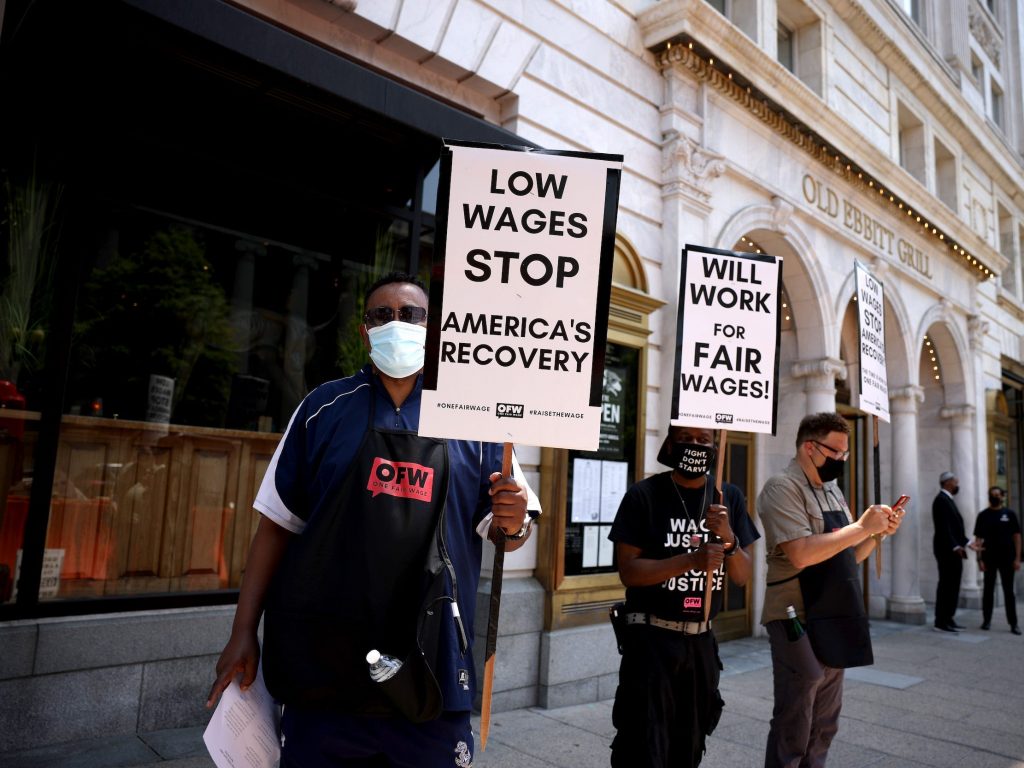
Anna Moneymaker/Getty Images
- Paul Constant is a writer at Civic Ventures and cohost of the "Pitchfork Economics" podcast.
- In his latest piece, he discusses the recent 12th anniversary of the last federal minimum wage raise to $7.25.
- Constant says if the minimum wage were tied to increases in worker productivity, it'd currently be at $24 an hour.
- See more stories on Insider's business page.
Saturday, July 24, was the 12th anniversary of the last time the federal minimum wage increased, to $7.25 an hour. This is, by far, the longest the nation has gone without an increase to the federal minimum wage since the labor law was first instituted in 1938. While many states and cities have long since raised their minimum wage to more than double the federal standard, $7.25 is still the wage for hundreds of thousands of workers in 20 states around the country.
While the federal minimum wage has stayed frozen in time for the last dozen years, prices have continued to increase. Economist Ben Zipperer reports that anyone who is "paid the federal minimum of $7.25 today effectively earns 21% less than what their counterpart earned 12 years ago, after adjusting for inflation."
At this point, the $7.25 minimum wage is a national embarrassment.
For decades, opponents claimed that raising the wage would kill jobs, close businesses, and move industries to states with a lower wage. But in cities like Seattle, where the minimum wage is now $16.69 per hour, those claims have been roundly disproven.
Study after study has shown that raising the wage doesn't kill jobs, raise prices, or shutter businesses because when workers have more money, they spend that money in local businesses, which then hire more workers to meet the increased demand.(You can find links to all those studies in a piece I wrote back in February debunking the five most common minimum wage myths.) Raising the wage is a no-brainer, but our lawmakers haven't found the political courage to act on it through years of Democratic and Republican leadership alike.
The one truly unanswered question that remains with the minimum wage is what standard should be used to determine the wage moving forward. A listener of the "Pitchfork Economics" podcast recently called in to ask why the minimum wage isn't tied to cost of living, for instance. Such a policy would have prevented the 21% decline in real spending power that minimum-wage workers are confronting right now.
As the system currently stands, opponents of minimum-wage increases only have to stall the legislative process to erode the strength and importance of the law, as these past twelve years of Congressional inaction have proven. It would make sense to peg the minimum wage to some sort of metric so it increases annually without any intervention from lawmakers.
Many states and cities around the country do this. My home state of Washington, for instance, pegs the minimum wage to inflation, so in January of this year the statewide minimum wage automatically ticked up from $13.50 to $13.69.
You could also argue that the minimum wage should be tied directly to worker productivity.
Virtually every Econ 101 class teaches the trickle-down myth that workers are paid what they are worth, and locking the minimum wage into national productivity numbers would be a way to finally ensure that claim is true.
This is the figure that would do the most for American workers. As a recent Economic Policy Institute paper found, productivity has increased by over 72% from 1979 to 2019, while worker pay has only increased by 17%. The minimum wage largely rose in lockstep with American worker productivity gains for its first three decades. But had the minimum wage kept pace with productivity increases since 1968, the federal minimum wage would be more than $24 per hour right now, according to the Center for Economic and Policy Research.
If we have learned nothing else from this shameful freezing of the federal minimum wage, it should be that the minimum wage is more than a number. No American should put in 40 hours of work only to find themselves trapped below the poverty line. Tying the figure to some kind of metric - be it cost of living, inflation, productivity, median worker pay, or something else entirely - is the only way to prevent 12 straight years of losses from happening to the American worker ever again.
Dit artikel is oorspronkelijk verschenen op z24.nl
